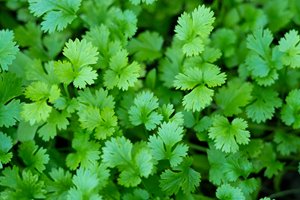
The fresh, citrusy flavours of coriander leaves make them a wonderful addition to your lunchtime or evening meals. Use them to cook or garnish and create tasty dishes from across the globe, such as curries or tacos.
If you're an avid gardener looking to insert its vibrant green hues into your outdoor space, you'll be happy to learn that it's relatively simple to produce. Read our guide to find out how to grow coriander from seeds.
When to grow coriander
If you're growing coriander from seeds, you'll usually sow them from April to October, or you can plant directly into the ground from April to June. Your crop should be ready to harvest from July to December, depending on when you planted.
How do you grow coriander?
You'll typically have two choices for growing coriander: from seed or pre-potted plants. You can buy them at garden centres, supermarkets or online.
How to sow coriander
Sow seeds outdoors if you're starting from scratch. Begin by finding a site with free-draining soil and access to shade and light. Next, make shallow drills and scatter your seeds. Cover with additional soil and lightly water.
If you don't have a ground site, coriander can also develop particularly well in pots and containers. Simply fill them with free-draining soil and firm it, before spreading your seeds along the top. Finally, cover with soil and gently water.
The germination process will take between one to three weeks and seedlings should show once this is complete.
How to plant coriander seedlings and leaves
Thin your seedlings out once they begin to appear. Ideally, they should be around 25cm apart to give the flowers and roots enough space to develop.
If you'd prefer a faster process, consider buying pre-potted plants and placing them directly into the ground from spring onwards. This can make the preparation easier and take the germination time away so you can get on with growing. Start by making a big enough hole in your soil or container, then place your coriander plant in, firm it and water well.
Creating the ideal coriander growing conditions
While growing coriander should be a relatively unchallenging task, there are still some things to be aware of as it matures.
- Watering: Keep your site moist but ensure you don't overwater and create a soggy environment.
- Dryness: Hot, dry weather can cause it to flower (bolt) prematurely, so water when necessary. If it does flower, remove them as needed.
- Pests: Young seedlings may be targeted by slugs and snails, but cloches can deter them allowing your crop to flourish.
- Feeding: While it doesn't need additional nutrients, you can give it a balanced liquid fertiliser for a boost.
- Weeding: Don’t let weeds steal light or water from your coriander. Remove them regularly to provide ideal growing conditions.
How to harvest coriander plants
Your leaves should be harvestable from midsummer onwards, depending on when you planted the seed. A good sign they're ready is when they turn a light green shade and are around 10-15cm tall. If you only take a few leaves from each plant, they should recover and produce more in the coming weeks.
Once washed with fresh water, you can eat coriander right away. If you'd like to store some, let the leaves dry then pop them in an airtight container or bag in a fridge, or you can freeze.
Growing coriander plants in a polytunnel
Coriander is a gardener's delight and shouldn't cause too many problems. However, a polytunnel could make your life even easier.
Our polytunnels come in a range of sizes to fit your space, and allow you to optimise conditions and extend the growing season. We also stock
accessories to help you get more from your outdoor area.
If you're thinking about investing in a polytunnel and need advice, call
01282 811250 or email
info@premierpolytunnels.co.uk to speak to one of our experts today. Be sure to read our other
growing guides for extra inspiration.